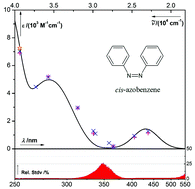The absorption spectrum of cis-azobenzene†
Abstract
Azobenzene is a prototypical photochromic molecule existing in two isomeric forms, which has numerous photochemical applications that rely on a precise knowledge of the molar absorption coefficients (ε). Careful analysis revealed that the previously reported absorption spectra of the “pure” isomers were in fact mutually contaminated by small amounts of the other isomer. Therefore, the absorption spectra of both trans- and cis-azobenzene in methanol were re-determined at temperatures of 5–45 °C. The thermodynamically more stable trans-azobenzene was prepared by warming the solution in the dark. To obtain the spectrum of cis-azobenzene three methods were used, which gave consistent results within the limits of error. The method based on the subtraction of derivative spectra coupled with a global analysis of the spectra recorded during thermal cis–trans isomerization is shown to give slightly more reliable results than the method using isomeric ratios determined by 1H-NMR. The described methods are readily generalizable to other azobenzene derivatives and to other photochromic systems. The practical implication of the re-determined ε values is demonstrated by a very high precision of spectrophotometric species analysis in azobenzene isomeric mixtures. The new ε values imply that the previously reported quantum yields must be revised.



 Please wait while we load your content...
Please wait while we load your content...